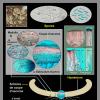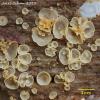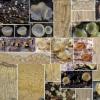
20-12-2025 23:08
Patrice TANCHAUDBonsoir, rÃĐcolte sur sol sablonneux dans l'arriÃ

20-12-2025 15:47
Mirek GrycHi.These grew on pine wood that was heavily covere

18-12-2025 21:17
Pol DebaenstThe identification took me to Byssonectria deformi

15-12-2025 07:09
 Danny Newman
Danny Newman
indet. Rutstroemiaceae sp. on unk. fallen leavesMc

19-12-2025 10:10
Patrice TANCHAUDBonjour, rÃĐcolte rÃĐalisÃĐe en milieu dunaire, a

18-12-2025 17:23
 Bruno CouÃĐ
Bruno CouÃĐ
Bonjour,je serais heureux d'avoir votre avis sur c

18-12-2025 18:07
Margot en Geert VullingsThese plumes were found on rotten wood.They strong

17-12-2025 18:35
 Michel Hairaud
Michel Hairaud
Bonjour à tous/Hi to everyone I am passing along
Bonjour !
Voici un Orbilia probable de la rÃĐgion de QuÃĐbec.
Merci de toujours nous aider dans nos identifications.
AmitiÃĐs ! Roland
DonnÃĐes :Â Â Â Â
Date de rÃĐcolte : 10 / 07 / 2-12
Substrat: feuillu pourri probable
HymÃĐnium couvert d'une substance gÃĐlatineuse recouvrant les paraphyses et asques d'une coiffe foncÃĐe (ÃĐpithÃĐcium ?)
Asques à 8 spores bisÃĐriÃĐes, cylindriques, attÃĐnuÃĐs à la base, non amyloÃŊdes ?,18,5-27 x 2,5-4 Âĩm
Paraphyses cylindriques, 1,9 Ã 2,6 Âĩm de diam.
Spores courtement filiformes à cylindriques, parfois lÃĐgÃĻrement arquÃĐes, hyalines, avec deux petites guttules polaires, 4,8-7 x 0,6-1 Âĩm, 5,9 x 0,8 Âĩm en moyenne, Q = 5,1=10, Q moyen = 7,6
Medulla Âą celluleuse, formÃĐe de cellules subglobuleuses à cylindriques
Excipulum (ental ?) en textura porrecta, formÃĐ d'hyphes ventrues, Ã paroi ÃĐpaissie jusqu'Ã 2,8 Âĩm, septÃĐes, 23,5-68,5 x 13,5-33,5 Âĩm
Excipulum ectal (latÃĐral ?) en textura prismatica, formÃĐ d'hyphes septÃĐes, Ã paroi ÃĐpaissie, courtes, 3,5-14 x 2-6 Âĩm
Subiculum formÃĐ d'hyphes peu abondantes, subglobuleuses à la base, septÃĐes, à paroi ÃĐpaissie jusqu'à 1,4 Âĩm, 4,2-10,2 Âĩm de diam.
Note : La petite taille de certains des ÃĐlÃĐments microscopiques et la prÃĐsence d'un ÃĐpithÃĐcium ont rendu les mesures et les observations difficiles à prÃĐciser.

this collection strongly resembles Hyalorbilia inflatula, the asci look like arising from croziers (Hyalorbilia) on Jacqeline's photostream. But perhaps Zotto has a different idea
best wishes,
Stip

Stip is right with Hyalorbilia, the asci have a rather wide, unstalked base  and certainly arise from croziers, unlike Orbilia. Also the excipulum is of a horizontal prismatica.
But H. inflatula has straight spores (or almost so). We have H. tortuosa and  H. fagi as the two species in question, both undescribed, and at least the latter quite frequent. But the two can not easily be separated. The best is when you find the conidia on the substrate (or in culture), they are quite different. From your narrow spore width H. tortuosa would better fit. Could you please send me spore photos with an included scale?
I attach a part of my key, so you can try whether you arrive at tortuosa.
The margin of your schematic section is not well figured, it needs to look round and a bit inrolled rather than cut. And the photo on the miidle left is misleading, it does not show a section but a squash mount. It pretends that the cells are oriented perpendicular to the surface while they run in fact parallel to the surface.
Â
Zotto
Thanks you for the key.
If I consider that the spores are at most arcuate or sometimes subheliocoid, the key gives H. inflatula.   Â
We will place new photo of spores.
Their dimensions are done with PiximÃĻtre.Â
Do you have ones that represent H. tortuosa, for comparaison.
We will make againt photos of excipulum and the margin.Â
We don't see conidia even when we observe the subicular hyphae on the substrat.  Â
We will give you more informations. Please stay with us to go on.    Â
AmitiÃĐs à vous et Stip !
Roland

Here a part of the H. inflatula plate where you see that the spores are generally straight or almost so. Â
Also plates of fagi and tortuosa in the documents below
Zotto
Thank you for the beautifull plates you place for us.
Now, we are sure that our Hyalorbilia is inflatula.
I change the micro plate of this species.
You will better see the spores and excipulum.  Â
It'is a pleasure to work with you and with the teem of Ascofrance !
Merci et amitiÃĐs !Â
Jules, Roland and Jacqueline Â
 Â

your spores partly look like inflatula but others are too much curved. I never saw inflatula like that. I know it is a very difficult group, and perhaps intermediate cases exist. We have a few records we cannot safely place. Regrettably we have much too few sequences to get a better idea.
If you saw any conidia (~30-40 x 4-5 Âĩm, multiseptate) in your collection this would be very helpful.
Could you please tell me  the locality where it comes from?
Thanks
Zotto
Here is the locality : ville Lac-Beauport, comtÃĐ de la Jacques-Cartier.
Finder :Â Jules Cimon
Herbarum :Â No 50466
                   Jules Cimon
                  5 chemin du Rouet Lac Beauport
                   G3B 0M3
                  QuÃĐbec - Canada
AmitiÃĐs !
Roland

Zotto
OK, now I change the data for the locality, finder and herbarum.
If it is not enough, please ask again !
Roland Â

Lac Beauport lies at 46° 56' N 71° 58' W at ca. 250 m alt.  Now, Jules Simon found it close to his home? And the number is his personal herbarium I think.
Zotto
Roland



 test
test